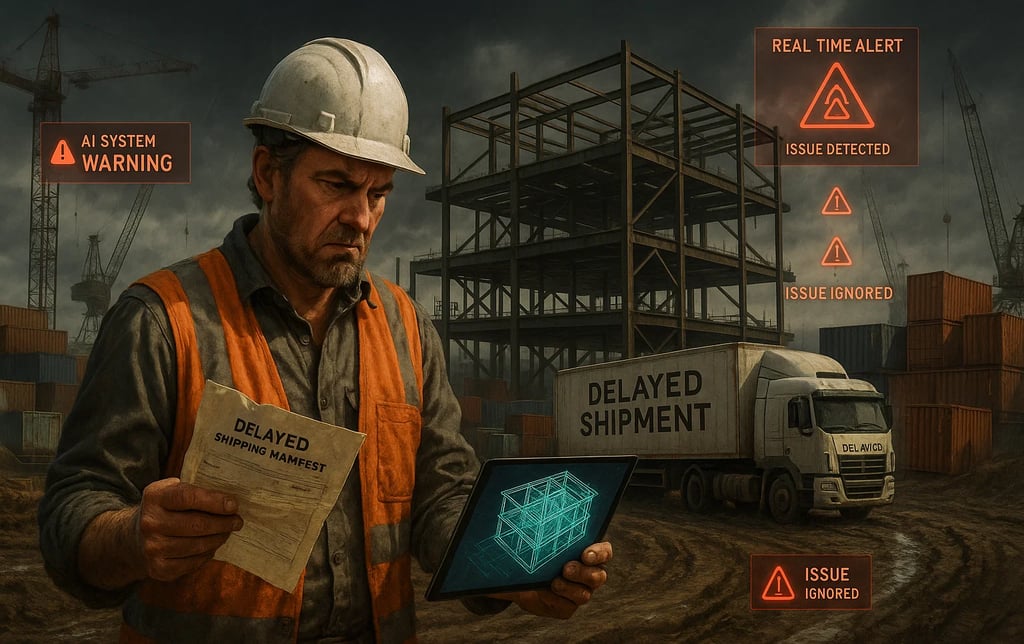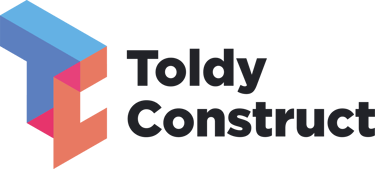Quality and technology IN CONSTRUCTION
delivered with STRAIGHT communication
The Future of the Construction Supply Chain After 2025 – What Is AI Worth When Steel Is Delayed?
The article highlights that in the construction industry, digitalization and artificial intelligence alone cannot solve issues like material shortages and logistical delays. Technology can only be effective when supported by reliable data and organizational readiness. The CSRD regulation, mandatory from 2026, will elevate supply chain transparency to a new level — making it not only an operational requirement but also a matter of competitiveness.
CONSTRUCTIONTRENDSME
Dr. Toldy Gábor - Toldy Construct
5/11/20253 min read


The Future of the Construction Supply Chain After 2025 – What Is AI Worth When Steel Is Delayed?
Redesign or Another Illusion? Since 2020, we have all learned that the global supply chain is not a symphony but a minefield. The pandemic, the Suez Canal blockage, the war in Ukraine, and conflicts in the Middle East have all confirmed what construction professionals have whispered for decades – materials do not arrive on their own, and digitalization alone does not pour concrete.
By 2025, we’ve moved beyond panic reactions. We don’t just want to survive; we want to build. The question is no longer which software to buy, but whether we know what we actually want to achieve with it. The following reflections unpack this dilemma.
1. Pain Points: When Steel Doesn’t Arrive on Time No leap in technology helps if the physical world resists. In the U.S., by the end of 2024, construction input prices were still 38% higher than before COVID. BIM models can look great, but reality can shatter project timing. Here comes the promise of local sourcing – but let’s not forget: cement still doesn’t grow on trees.
➡️ Lesson: “Design-for-substitution” isn’t an option, it’s a survival strategy. Pricing and logistical risks must be simulated already in the concept phase – otherwise, we might lose the bid during the tender process.
2. Diversification ≠ Security (By Itself) As we step out of local chaos, it's easy to walk into global disorder. Many still treat diversification as a magic word – new suppliers, new regions, new opportunities. But this also brings more contracts, more responsibility, more audits – and most importantly, more risk.
For example, a Central European general contractor began using Turkish and Serbian steel after Brexit. Delivery became faster, but quality assurance audit costs rose by 18%. The supply chain didn’t get shorter – it just introduced different problems.
➡️ Lesson: Diversification is only valuable when supported by data-driven decisions and a working CLM (Contract Lifecycle Management). Without managing complexity, new partners only mean new failure points.
3. Artificial Intelligence: Miracle or Frosting? GenAI is now part of the supply chain narrative. In some places, it visualizes inventory as a control tower; in others, it models dynamic pricing. The problem? The software is faster than the organization. According to a PwC survey, the biggest obstacle isn’t technology – it’s people: data cleansing, lack of skills, and decentralized decision-making.
➡️ Critical question: Do we know what questions we want to ask the system? A "smart" system will answer dumb questions too – just not with useful answers.
4. Blockchain on Site: Reality or Illusion? In theory, blockchain promises transparency – but in practice, it's only as reliable as its data sources. If a subcontractor manually uploads a delivery note, the error becomes part of the system. Moreover, there’s often no unified data language between ERP, BIM, and logistics platforms – Excel remains the fallback.
➡️ The harsh reality: Technology is only as good as its inputs. Without standardized data catalogs, blockchain is just a fancy mirror reflecting chaos.
5. Mandatory Transparency: CSRD and Digital Reality From 2026, CSRD and CSDDD take effect – not as recommendations, but mandatory reporting obligations. In project financing, real-time material origin information is increasingly required. If you can’t prove where your steel comes from, banks won’t give you green financing – or only at higher interest rates.
➡️ Strategic stake: Supply chain transparency is not just an audit issue – it’s a competitive advantage in financing, ESG rating, and market reputation.
6. ROI? Only Through System Thinking Today, every company invests in digital tools – but most do so in isolated islands, not end-to-end. A GenAI module solves nothing if logistics data is outdated, contracts aren’t digital, and there’s no authority to make decisions.
📊 Examples of real ROI:
Blockchain pilot: €5M investment → €1.2M annual savings from reduced warranty recalls.
IoT sensor network: 8% waste reduction, 5% labor time savings.
GenAI in procurement: lead time reduced from 12 to 9 weeks – but only after the third data maintenance cycle.
➡️ Lesson: ROI doesn’t depend on the technology, but on whether the organization can embrace operational change.
Final Thought: The Weakest Data Point Will Define the Future Post-2025, the winners in construction won’t be those with the most software, but those who understand what’s happening in their systems. The future of the supply chain isn’t another digitalization project – it’s a cultural shift. A mindset where data, physical logistics, and strategic thinking can move in sync.
📌 “The strength of the chain depends on the accuracy of its weakest data point.” – and from 2026, this won’t be philosophy, but regulation.
Sources:
CSRD and CSDDD Directives – Wikipedia
Omnibus Simplification Package – Reuters
CSRD compliance costs – The Times
Supply chain challenges in fashion and manufacturing – McKinsey, World Economic Forum
Construction
With over 20 years of experience in general contracting, our company specializes in the flawless execution of unique, bespoke buildings. Our innovative methods and mindset make us stand out in the market.
Our services
Contacts
company@toldyconsult.hu
+36 30 289 2383
© 2024. All rights reserved.
Our WEBPAGES
www.toldyconsult.hu
